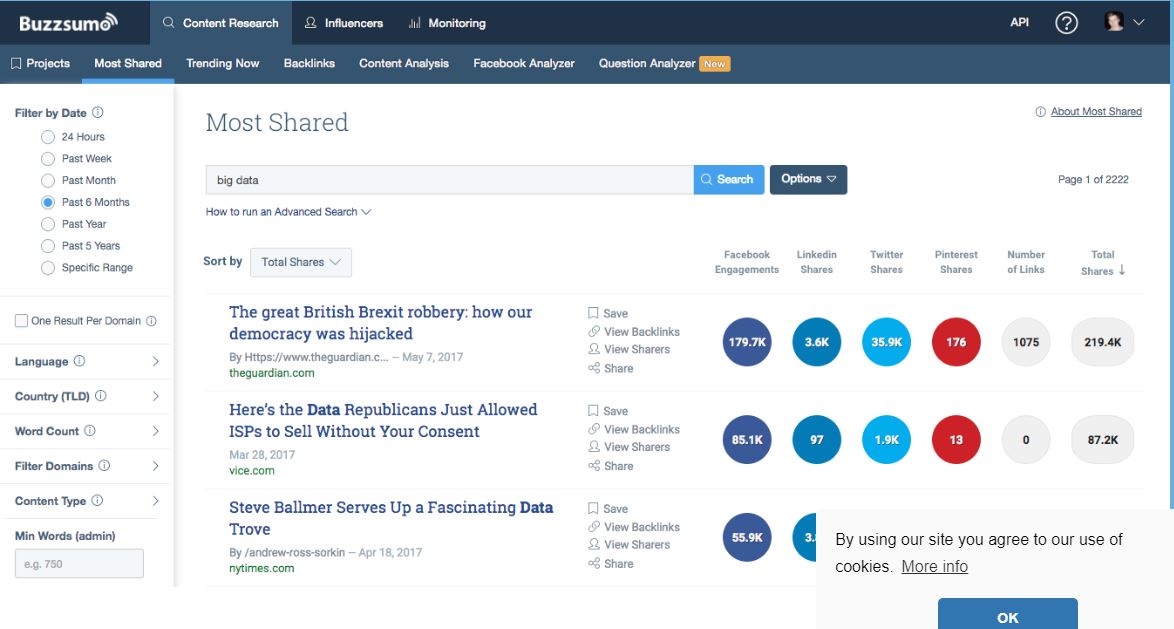Whether you plan on becoming a content writer yourself, or if you plan on outsourcing content to another writer (or group of writers), it’s critical to know how to research, write, and distribute quality content.
Today, we’ll go over how to do research for your content so you know exactly what your audience wants to see from you, a solid framework that you can use to write quality content repeatedly and predictably every time, and how to best outsource your content should you need to take some weight off your shoulders.
Researching Content
Finding Topics From Your Previous Content

If you already have your own content, you can use this strategy to build upon what your readers enjoyed most from your content up to this point.
1. Use Alexa to find your basic numbers and demographics

If you have a decent blog following, you can go to Alexa to figure out your current demographics. Here’s how to do just that:
1. Go to Alexa.com/siteinfo to use the free version of Alexa
2. Enter your blog’s URL
3. Click the “Find” button
4. Scroll down until you see the “Country” heading
You will need to pay for a premium plan to see more expanded metrics, but you can see where most of your visitors are coming from using the free version. Take note of the countries where your readers are coming from.
5. Analyze engagement metrics.
Look at how your readers are engaging with your site. Here are the metrics to look at, and what they mean:
- Bounce Rate – This means how many people land on the first page and then leave almost immediately without looking at anything else on your site. Maybe they get the answer they need then leave.
- Daily Pageviews – How many pages on your site the average visitor goes to each day.
- Daily Time On Site – This measures the average time visitors spend on your site.
6. Consider your top keywords
Notice which keywords are driving the most visitors to your website. This shows you what your readers are interested in. Focus on giving your readers what you perceive that they want based on the data you get.
7. Look at your competitors
It’s important to see what your competition is doing because these sites are producing content that is similar to yours. However, they may be doing some things differently that may provide them with different results.
Pay attention to what they’re doing; your competitors might show you an opportunity where you can improve.
8. Look at your demographics data
This helps you understand who your readers are, what their education level may be, and where they view your content.
2. Use Google Analytics to discover your most visited content

To get more advanced information, you want to go into Google Analytics.
1. Sign into Google Analytics
2. Navigate to Behavior → Site Content → All Pages
3. Look at your top ten most visited pages.
What you’re looking at here are the pages on your site that have the most pageviews. Look and see if there are any blog articles that are on that list.
If there are any blog articles on that top ten list, it tells you a couple things:
- That specific article has good SEO and/or social sharing.
- That specific article is appealing to your readers.
Now look at each of the standard metrics in this report and ask these questions:
- Pageviews – How many times was the page visited? (This number doesn’t tell you how many unique people visited the page; it could’ve been viewed multiple times by the same people)
- Unique pageviews – This gives you a closer idea of how many unique people visited the page.
- Avg. Time on Page – How long did each reader spend on the page?
- Entrances – Was this the first page on your site they visited?
- Bounce Rate – How many people looked at this page only, and then left?
- % Exit – For how many people was this the last page that they read on the site?
3. Use BuzzSumo to find your top-shared pages

With the information we just gathered, form demographics and web analytics, we now go over to BuzzSumo for social analytics. That will help us figure out what content your readers think is awesome.
1. Go to Buzzsumo.com
2. Type in your website name and click “Go”
If your blog has its own subdomain, use that subdomain. So if your blog starts at “example.com/blog” and not “example.com” use the URL with “/blog” at the end.
3. Take a look at which of your blog articles have the highest number of social shares.
If readers are sharing your content, it’s a sign that the content is good. They like it, they promote it, and they share it, because they think it’s awesome!
Now you have an example of the kind of content you should create from now on.
After looking at your metrics from BuzzSumo, there are 5 questions that you should ask about your top performing content. These questions will help you create content that your audience will resonate with most:
1. What kind of title does this article have?
Use this kind of title for your future posts.
2. How long is the article?
Make your future articles this many words or longer.
3. How many images does this article have?
Use this number of images, style of images, and type of images in your future posts.
4. What subject matter does the blog article deal with?
Focus on similar or related topics in future content.
5. What kind of comments did people leave on your article?
What are they praising (so you know what you need to keep doing)? What are they complaining about ( so you can correct it)? What questions do they ask (so you can answer them in future content)?
Finding Topics From Your Competitors’ Content

This is a great tactic to use, especially if you don’t have your own content yet.
1. Find your competitors using Alexa
Go to to Alexa.com/siteinfo. Type in the name of your site, and click “Find.” Keep scrolling down until you find the section called “Similar Websites by Audience Overlap”
After you see that list of competitors, go check out those websites to see what they’re all about. Find out what topics they cover, how much content they’re producing, and other information that could be relevant.
2. Type your competitors’ URL into BuzzSumo
Go to BuzzSumo, type in your competitors’ URL, and click “Go.”
Take a look at the top five shared articles, and research each article to find out the following information:
- What is the topic of that article?
- What is the title?
- How many words is the article?
- How many images are in the article?
Read the article carefully and absorb as much of the style and approach as possible. This way you can replicate that style in future articles.
3. Repeat steps 1 and 2 with your top 5 competitors
If your competitors are doing a great job, by all means find out what they’re doing and model it as closely as you can.
The Content Creation Formula

Now that you finished research for your content, it’s time to cover how you want to put that research to use and create your own awesome content. The easiest and best way to get predictable results is to follow a tried and proven formula.
A blogging formula is a set of strict guidelines that you follow every time you blog. Below is an example from neilpatel.com of a formula you can use right away.
Topic
- Make it relevant
- Tell readers how to solve a problem or achieve a goal
- Explain precisely how to do it
- Make it useful
Intro
- About 100-150 words
- 7-10 paragraphs
- USe several one-line paragraphs
- Talk directly to the reader
- Ue several first-person references
3-50 main headings
- Make the headings easy to understand and follow. Use full sentences or phrases
Body
- Keep the language simple
- No big words
- Use short paragraphs, no longer than 3 lines
Images
- Use at least 10 images
- Do not use clipart… ever.
- Use data-driven images, like charts, graphs, and screenshots
Conclusion
- Close with 3-10 paragraphs
- Last line should be an italicized question
- Don’t be afraid to ask for feedback
Keywords
- Make sure you have your target keywords in your title, body content, and meta tags
Use this formula as a framework to ensure you produce quality content that your readers will want to come back to over and over again.
It’s also important to have a content creation formula set up when you decide to outsource your content. This way the writers you hire have a better idea of how you want them to write their content to fit your needs.
Best Methods for Outsourcing Content Creation

You may, at some point, run into a situation where you will need to hire on more writers to be able to publish all of the content that you need to publish on a daily basis. You may need one writer or several, but it’s important to know where to hire good writers for your content.
This section will lay out various providers you can use to outsource your writing tasks, as well as some pros and cons of each.
Hiring writers in-house
There are quite a few upsides to hiring your own in-house writing staff.
For one, this arrangement can provide a great deal of flexibility. You can train these writers to write, format, upload, or whatever else you need. It provides the ultimate individual approach for your content.
You can also pay different rates depending on the content you need.
Outsource to someone in an agency
The quality of work can vary wildly between content agencies. There are some agencies that focus on large batch content delivered quickly, and others focus a lot more on quality over quantity. Others focus more on rewriting content instead of writing fresh content from scratch.
In general, your prices for these outsourced articles will vary depending on:
- Quality of the article
- Article length
- Expertise of the author on a specific subject
- How complicated the subject matter is
If they’re writing about more complicated topics, you’ll likely have to pay your writers more since they have to have specialized knowledge of, and/or do deep research on, that subject.
This is especially true if you’re needing content on a highly technical topic (such as legal terms, accounting information, legalities of taxes, etc.)
Let’s go through some of the more prominent agencies and providers in detail:
iWriter
If you want low-cost articles and you don’t really care too much about quality, iWriter is who you want to use. They are the cheapest on this list by far.
They can also deliver large batches of articles within 48 hours.
If you get articles that are just plain horrible, you can flag them and get those articles rewritten within 24 hours. However, on average the quality of articles from iWriter may not be up to the standards you’re looking for.
WriterAccess
WriterAccess is a dedicated writing agency. They have a large pool of content writers that can serve thousands of clients. They offer various qualities of articles that range from 2 to 6 stars. WriterAccess charges per word.
WriterAccess’s 5 and 6 star writers will write for you high-quality articles. If you need well-researched and well-written content, and you’re prepared to pay a premium for that quality, WriterAccess is a good option to go with.
They can also add character and humor to your articles if you wish. They can also be technical and professional.
Because of this skill level, pricing is a bit higher than other agencies.
TextBroker
TextBroker also provides content at various quality levels. Their 4 and 5 star writers write decent content.
TextBroker has great customer service going for it. They will be able to offer you a representative who will handle all the ordering details and delegating the work top the writers.
However, the article ordering system is not as easy to use as iWriter and WriterAccess.
Constant-Content.com
Constant Content has a unique focus on software product reviews. Their writers will go into the backend of their software, play around with it, get screenshots, and write an informative review on the product.
Because of how specialized this service is, they do charge more, but the potential revenue you can get from this kind of content can be substantial.
Outsource to Freelancers
The following options for content writing are great if you don’t need an online agency or service. With a little creativity, you can have excellent content written for you from other sources.
Upwork
Upwork, a merger of Elance and Odesk, is a freelancing website that brings employers and freelancers together.
Upwork handles all the payment aspects to make the entire process as safe and secure as possible for you and the freelancer. Just enter your payment info, set the rates you want to pay, and Upwork handles the rest.
Generally, you’ll have to pay good rates for quality writers, particularly for those with niche-specific expertise. They’re in demand and they charge premium rates.
There are some excellent writers on Upwork, but it can be hit or miss at times. Sometimes you may pay a premium for crap work, and other times they may disappear if they end up with a hiccup in their schedule that prevents them from completing the project you assigned them on time.
Hiring College Students
If you need a custom article on any topic, one fantastic source for content is college students. They have access to libraries for research, they usually write reasonably well, and they work for reasonable rates.
Remote part time writing work is great for college students so they’re happy to get the work. When you post your writing job listings with the university or college career services, you can end up getting a lot of applicants.
However, college students can have unpredictable schedules that can change throughout the semester, and from semester to semester. An an employer you must let yourself be flexible with your demands.
OnlineJobs.ph
OnlineJobs.ph is a site specifically for hiring freelancers in the Philippines. While they’re not fluent native English speakers, they write at an acceptable level for specific types of jobs. However, using them for longer, more in-depth content pieces wouldn’t be recommended.
For article writers form this site you can expect to pay $3 to $8 per hour, and they will work very hard to get the work done for you.
Wrapping it Up
Whether you plan on becoming a content writer yourself, or if you plan on outsourcing your content to third-party sources, it’s important to know the process of researching, writing, and distributing quality content.
For outsourcing it’s critical so you know how to educate your writers on how you want your content to turn out, so they can write that content that accomplishes what you want it to.
However, even with knowing all of this information, it can still take a lot of time and energy to get everything in place for your content marketing strategy. Let us take that burden off of your shoulders so you can concentrate more on tasks that only you can do for your business.







Leave A Comment